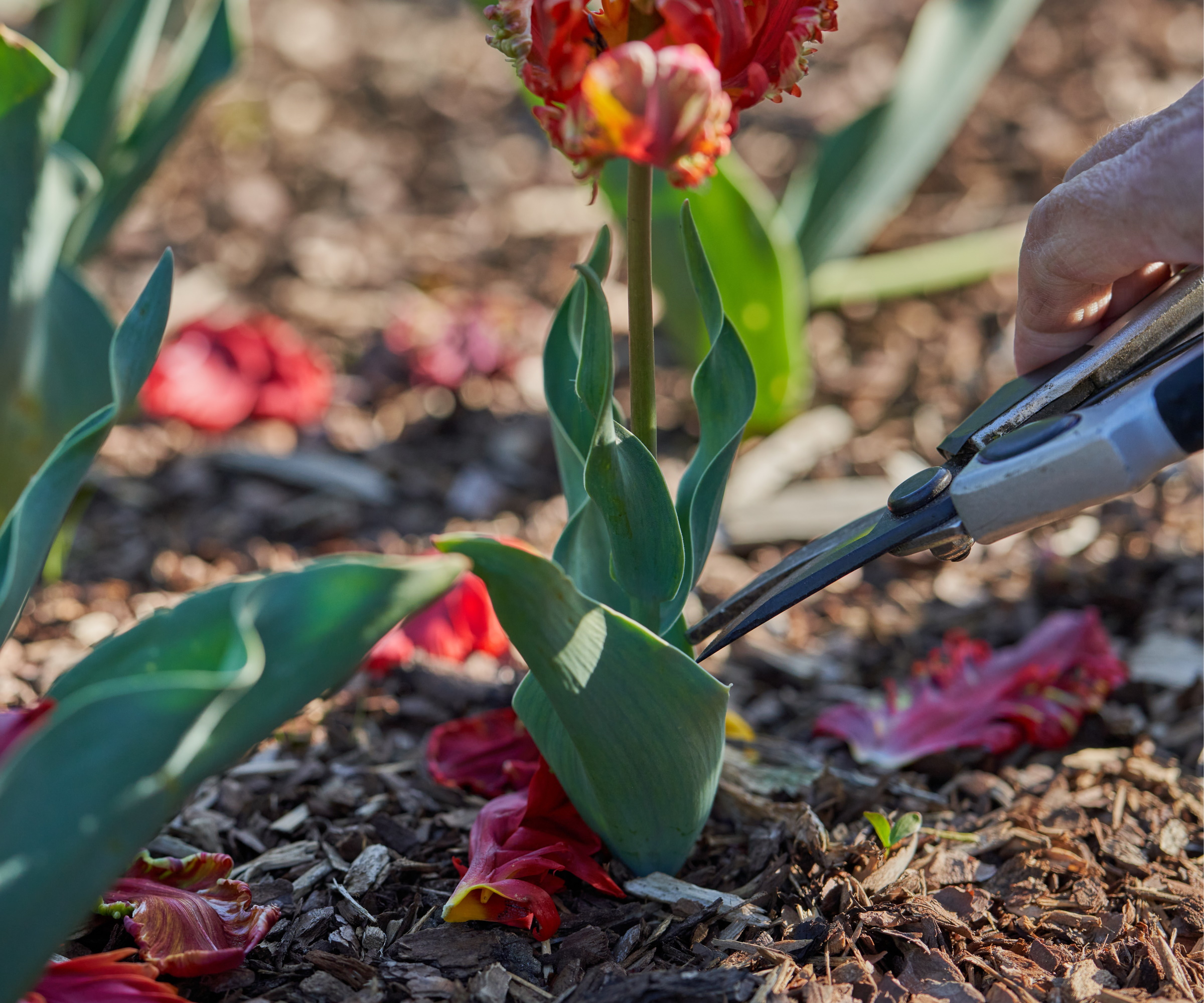As tulip season comes to a close, the once-vibrant blooms begin to fade, leaving behind wilted flowers and yellowing foliage. Many gardeners wonder when exactly they should cut back dead tulips. Timing is crucial for encouraging healthy regrowth and ensuring a vibrant display the following spring.
The best time to cut back dead tulips is after they have finished blooming and once the leaves have turned yellow. This yellowing indicates that the plant has completed its photosynthesis cycle and has begun redirecting energy back into the bulb for next year’s growth. Cutting too early can reduce the plant’s ability to store nutrients, while waiting too long risks attracting pests and disease.
To properly cut back the tulip, use a pair of clean, sharp shears or a knife and cut the stem about an inch above the soil level. Avoid damaging nearby bulbs, and ensure you remove any mushy or moldy foliage to prevent fungal issues in the soil. This simple step can make a major difference in the health of your tulip bed.
How to Tell When Tulips Are Ready for Cutting

Knowing the right time to cut dead tulips starts with observation. After the flowers bloom, keep a close eye on the leaves and stems. Healthy tulip foliage will remain green for a few weeks after the blooms have faded. This period is essential, as the leaves are still absorbing sunlight and converting it into energy stored in the bulb.
When the leaves begin to yellow and wither, the plant is signaling that it has finished its life cycle for the season. At this stage, you can safely begin trimming the dead portions. Never cut green leaves unless absolutely necessary, as this will hinder the bulb’s ability to recharge for the next blooming season.
Additionally, check the surrounding soil and moisture level. Tulips do not like overly wet conditions once blooming has ended. If the soil is too moist, cutting back early may help prevent rot. Proper timing not only supports regrowth but also maintains overall garden hygiene.
How to Cut Tulips to Encourage Regrowth
If you want your tulips to come back strong next year, learning how to cut them correctly is essential. Always cut the stem at a 45-degree angle. This diagonal cut increases surface area for water absorption and reduces the risk of stem rot, especially when displaying cut flowers indoors.
Remove all foliage from the cut stem to prevent decay in the vase. Leaves left in water can break down and introduce bacteria that shorten the lifespan of your flowers. For garden tulips, focus on cutting flower stems only once the plant has entered its post-bloom phase, and avoid cutting the green leaves.
Use a sterilized knife or pruning shears to ensure a clean cut. Dirty tools can transmit disease between plants. Once cut, place fresh-cut tulips in clean water immediately, and refresh the water every few days to maximize bloom longevity. For garden regrowth, don’t disturb the bulbs and avoid compacting the soil around them after cutting.
What to Do With Tulips After They Die
Once tulips have completely died back, you can take a few key steps to prepare your garden for the next season. Deadheading the flowers (removing spent blooms) during the blooming season can already help by preventing seed formation and redirecting energy to the bulb. But after the foliage dies, it’s time to clean up thoroughly.
Start by removing the stems and leaves, cutting close to the ground without disturbing the bulb. If your tulips are in containers, you may choose to lift the bulbs at this point. Shake off any loose soil and inspect bulbs for signs of rot or mold. Discard any damaged ones.
For composting, cut the stem off about an inch from the bulb, remove dirt, and allow the bulb to dry before storing it in a cool, dry location. If you choose to leave bulbs in the ground, apply mulch to protect them over winter. Proper cleanup not only enhances appearance but helps prevent fungal or pest issues in the following season.
How to Prune Tulips for Healthier Growth
Pruning tulips doesn’t require much effort, but consistency is key. After the bloom fades, resist the urge to cut the leaves immediately. Let the foliage remain until it has turned yellow and collapsed naturally. This delay allows the plant to channel nutrients into the bulb, which is essential for next year’s bloom.
Once the foliage has fully yellowed, use sharp, sanitized shears to trim the leaves back to just above the soil line. Don’t yank or twist the leaves, as this can damage the bulb or disturb surrounding plants. A clean cut helps minimize infection risk and speeds healing.
Pruning also helps control overcrowding and keeps the flowerbed looking tidy. For areas with heavy tulip growth, pruning may be followed by bulb division every few years. This will improve air circulation and reduce competition for nutrients, resulting in more vigorous blooms.
How Often Should You Cut or Prune Tulips?
Tulips require pruning once per year, typically after they bloom in spring. Annual pruning is enough to maintain healthy growth, prevent disease, and keep your flowerbeds neat. Deadheading, which involves removing spent blooms, can be done during the flowering season to conserve the plant’s energy.
Once blooming is complete, wait until the leaves turn yellow or brown before performing the final pruning. Avoid cutting too soon. If pruned prematurely, tulips may store less energy, leading to fewer and smaller flowers the following year.
Regular yearly pruning paired with proper soil nutrition and adequate sun exposure ensures that your tulips return stronger each season. Over time, this annual maintenance routine will improve bulb health and prolong the life of your tulip displays.
What Month Should You Cut Back Tulips?
The best time to cut back tulips generally falls in late spring to early summer, depending on your climate. In most regions, this is around late May to mid-June. By this point, the blooming phase has ended and the leaves begin to yellow, indicating that the bulb is entering dormancy.
If you cut back too early, before the leaves have yellowed, the bulb may not store enough energy for the following year. Conversely, if you wait too long, dying foliage may attract pests, mold, or make your garden look unkempt. The key is finding the right balance.
Gardeners in colder zones may need to cut back slightly earlier, while those in warmer areas may wait until early July. Regardless of location, always observe the foliage as your primary indicator for timing.
Should You Deadhead Tulips?
Deadheading tulips is a smart practice if you want to prolong bulb vitality. When a tulip flower fades, it begins to form a seed head. This process uses a significant amount of the plant’s energy. By removing the spent bloom early, you redirect energy back into the bulb.
Deadheading is simple: just snip off the faded flower head without touching the leaves. This step won’t cause the plant to rebloom in the same season, but it ensures a better show the next year. Be gentle and use sanitized tools to avoid damaging the plant.
While not absolutely necessary, deadheading is especially helpful for hybrid tulip varieties, which rely heavily on stored nutrients to thrive year after year. It’s an easy way to improve both bulb strength and garden appearance.
Can You Cut Easter Lilies the Same Way as Tulips?
While tulips and Easter lilies both benefit from end-of-season care, their cutting methods differ. Tulips can be cut back shortly after the foliage dies, but Easter lilies require more patience. Lilies should not be cut until after the entire plant, including the stem and leaves, has turned brown and brittle.
Cutting Easter lilies too early can hinder the bulb’s ability to store energy and may reduce blooming for the next year. Use clean shears and cut close to the ground once the plant is fully dormant. Unlike tulips, lilies tend to benefit from remaining in the soil undisturbed over several seasons.
Both plants thrive with proper timing, but understanding their different life cycles ensures healthier regrowth and prevents common mistakes.
Conclusion: The Right Way to Cut Dead Tulips
Cutting dead tulips is a crucial step in post-bloom garden care. The key is timing: wait until the leaves have yellowed and the plant enters dormancy before pruning. Use clean tools, cut low to the ground, and avoid disturbing the bulbs.
Annual pruning supports strong bulb development, helps prevent disease, and keeps your garden beds looking neat and healthy. Whether you’re deadheading during the bloom period or cutting back after flowering, consistent care ensures your tulips return brighter and fuller each spring.






